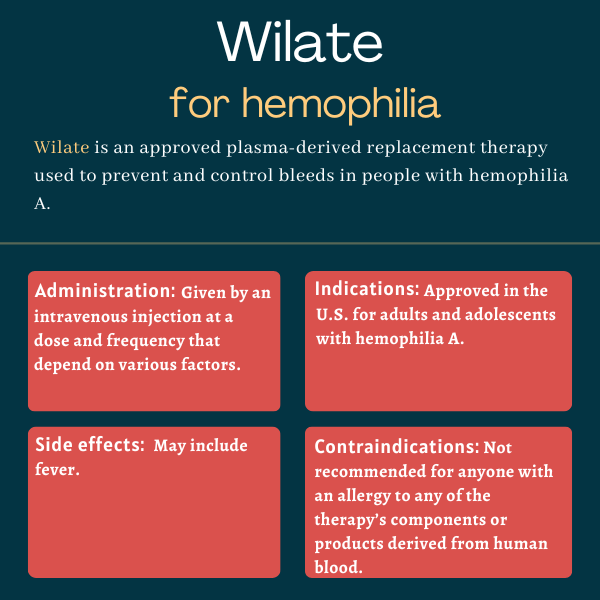Wilate (human von Willebrand factor/coagulation factor VIII complex) for hemophilia
Last updated Oct. 3, 2024, by Marisa Wexler, MS

What is Wilate for hemophilia?
Wilate (human von Willebrand factor/coagulation factor VIII complex) is a plasma-derived replacement therapy that’s approved to control and reduce the frequency of bleeding episodes in adults and adolescents with hemophilia A.
The therapy, which is administered via an injection into a vein, or intravenously, is also approved to prevent and control bleeds, including those that happen during surgery, in children and adults with von Willebrand disease (VWD), another bleeding disorder.
Wilate is marketed by Octapharma.
Therapy snapshot
| Brand name: | Wilate |
| Chemical name: | Human von Willebrand factor/coagulation factor VIII complex |
| Usage: | Prevention and control of bleeding episodes in people with hemophilia A |
| Administration: | Intravenous injection |
How does Wilate work?
Hemophilia A and VWD are bleeding disorders wherein genetic mutations impair the function of proteins needed for the blood to clot. In hemophilia A, there is a deficiency in clotting factor VIII (FVIII), while VWD is characterized by a deficiency in von Willebrand factor (VWF), another protein involved in blood clotting.
Wilate contains versions of both FVIII and VWF, which are purified from large pools of human plasma — the liquid portion of blood — gathered at donation centers. By providing the two proteins, Wilate should restore blood clotting in people with hemophilia A or VWD.
Who with hemophilia can take Wilate?
The U.S. Food and Drug Administration (FDA) approved Wilate for adults and adolescents with hemophilia A in October 2019. The therapy is indicated for use as an on-demand treatment to control bleeds, as well as a routine prophylactic (preventive) treatment to reduce the frequency of bleeding episodes.
Wilate was first approved by the FDA for VWD in 2009. That approval has been expanded and Wilate is now indicated for use in children and adults with all types of VWD as an on-demand, prophylactic, or perioperative treatment.
Who should not take Wilate?
Wilate is contraindicated, or not recommended, to anyone who is allergic to any of the therapy’s components, along with people with a known history of allergies to products derived from human blood.
How is Wilate administered in hemophilia?
Wilate is available in single-use vials containing either 500 or 1,000 international units (IUs) of both FVIII and VWF. The therapy is designed to be reconstituted, or diluted in 5 or 10 mL of a sterile solvent, and then administered via a slow injection into the bloodstream, at a rate of 2-4 mL per minute. Because Wilate contains no preservatives, it should be administered within four hours of being reconstituted.
Injections should be given by a healthcare professional. Patients or family members also may be able to prepare and administer the therapy after receiving appropriate training.
When used as on-demand treatment to control bleeds in hemophilia A, the dose and duration of treatment with Wilate depend on bleed severity:
- For minor bleeds, a dose of 30 to 40 IU per kilogram of body weight (IU/kg) should be given every 12 to 24 hours for at least one day until the bleed has resolved.
- For moderate bleeds, a dose of 30 to 40 IU/kg should be given every 12 to 24 hours for at least three or four days until the bleed has resolved.
- For major bleeds, a dose of 35 to 50 IU/kg should be given every 12 to 24 hours for at least three or four days until the bleed has resolved.
- For life-threatening bleeds, a dose of 35 to 50 IU/kg should be given every eight to 24 hours until the threat has resolved.
In adults and adolescents with hemophilia A who are using Wilate as a prophylactic therapy, the recommended dosage is 20 to 40 IU/kg, given every two to three days. The doses and frequency of administration may be adjusted by a healthcare professional based on a patient’s clinical status and response.

Wilate in hemophilia clinical trials
Wilate’s approval for hemophilia A in the U.S. was based mainly on data from an open-label Phase 3 clinical trial (NCT02954575). The study enrolled 55 male patients, ages 12 and older, who had severe hemophilia A (FVIII activity levels below 1% of normal without treatment). All the patients had been on a FVIII replacement therapy before entering the trial, where all were treated with Wilate for six months. The therapy was given at the dosage now approved for routine prophylaxis.
In both adults and adolescents, the median annualized bleeding rate for all types of bleeds and for spontaneous bleeds was zero, indicating that a large portion of participants had no bleeds, including those occurring spontaneously, during the study.
Indeed, more than half (56.4%) the patients had zero documented bleeds. Another 21.8% had just one bleeding episode during the six-month study, while 14.6% had two or three episodes and 9% had five or more bleeding episodes.
During this trial, 57 bleeding episodes were managed with Wilate given on an on-demand basis. Most (63.2%) of these bleeding episodes resolved with a single injection of the therapy and less than 4% required more than three injections to resolve. The efficacy of Wilate was rated as “excellent” in 28.1% of the treated bleeds, as “good” in 56.1% of the treated bleeds, and as “moderate” in the remaining 15.8%. Thus, more than 80% of the bleeds were treated successfully.
Ongoing trials
Octapharma is sponsoring an observational study called Protect-NOW (NCT03695978) to collect data on the use of Wilate and other therapies in people with hemophilia A who haven’t received treatment previously or who’ve received only minimal treatment, which is defined as less than five days on another FVIII replacement therapy. The study, which is expected to run through 2030, seeks to assess the therapy’s effectiveness, safety, and usage in real-world settings.
Wilate is also one of the treatments being assessed in the MOTIVATE study (NCT04023019), a trial sponsored by Emory University that seeks to collect data on the management of hemophilia A in patients who develop inhibitors, that is, neutralizing antibodies that can reduce the efficacy of hemophilia replacement therapies.
Common side effects of Wilate
In clinical trials of hemophilia A, the most commonly reported side effect of Wilate was pyrexia, more commonly known as fever.
Allergic reactions
Allergic reactions to Wilate may occur, with symptoms including swelling, tingling or chills, flushing, rash or hives, headache, low blood pressure, lethargy or restlessness, vomiting, wheezing, and burning or stinging at the injection site. For this reason, patients should be closely monitored for any signs or symptoms of an allergic reaction during administration.
If an allergic reaction occurs, the therapy should immediately be discontinued and appropriate supportive treatment given. Patients having an allergic reaction also should be evaluated for the presence of inhibitors.
Development of inhibitors
People with hemophilia or VWD may develop neutralizing antibodies against replacement therapies such as Wilate. These neutralizing antibodies are called inhibitors because they may stop the therapy from working as expected.
Patients should be regularly tested for the presence of inhibitors and to evaluate their clotting activity levels, especially if treatment isn’t working as anticipated.
Blood clotting
Wilate is designed to promote blood clotting. To ensure that clotting protein levels don’t get too high, which can increase the risk of blood clot-related problems, clotting protein activity levels should be regularly monitored for patients on Wilate.
Transmission of infectious agents
Since Wilate is made from human blood, there’s theoretically a risk that the therapy could transmit infectious agents, such as viruses. With modern manufacturing and screening procedures, the likelihood of such an issue is slim to none. Even so, the batch number of every Wilate injection should be recorded and if any infection is thought to be even possibly related to the therapy, it should be reported to Octapharma at 1-866-766-4860. Vaccination against hepatitis A and B viruses could also be considered in patients regularly receiving Wilate.
Use in pregnancy and breastfeeding
Wilate has not been rigorously tested in women who are pregnant or breastfeeding. Thus, it’s not known if the medication can be harmful to the developing fetus, pass into breast milk, affect milk production, or the breastfed infant. In one clinical study, four patients with VWD were treated with Wilate during labor and delivery and no issues were reported.
Patients are advised to discuss with their care team to understand the potential benefits and risks of using Wilate during pregnancy or breastfeeding in order to make an informed decision on whether or not to use the therapy.
Hemophilia News Today is strictly a news and information website about the disease. It does not provide medical advice, diagnosis or treatment. This content is not intended to be a substitute for professional medical advice, diagnosis, or treatment. Always seek the advice of your physician or other qualified health provider with any questions you may have regarding a medical condition. Never disregard professional medical advice or delay in seeking it because of something you have read on this website.
Recent Posts
Related articles






